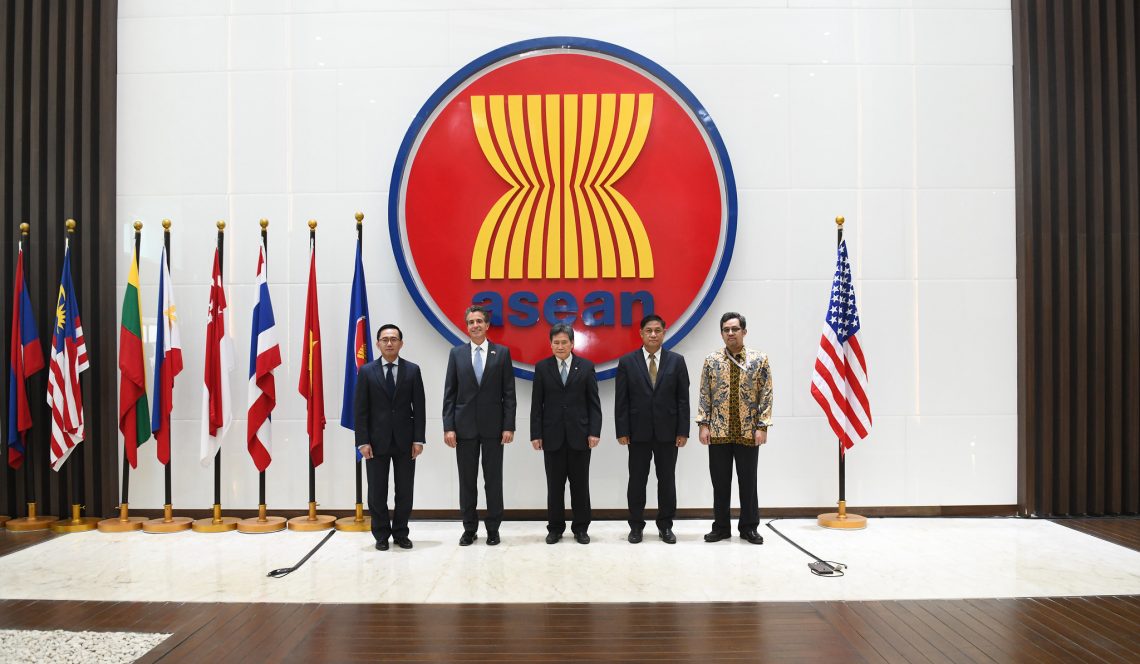JAKARTA, 10 September 2020 – Today, ASEAN Secretary-General Dato Lim Jock Hoi and US Agency for International Development (USAID) Principal Officer to ASEAN Ryan Washburn signed the Regional Development Cooperation Agreement (RDCA) between ASEAN and the United States of America.
The RDCA will contribute to strengthening ties and continuing links of friendship between ASEAN and the United States, advancing sustainable and inclusive growth and development. It will encourage rule-based systems in support of a peaceful, secure and prosperous ASEAN, in line with the ASEAN Community Vision 2025, the ASEAN-U.S. Plan of Action (2021-2025) and the Joint Statement of the ASEAN-U.S. Special Summit.
In his opening remarks, Dato Lim Jock Hoi said, “the U.S. shall continue to be one of ASEAN’s key dialogue partners in our Community building efforts. We look forward to the implementation of projects and programmes to be supported by the RDCA in response to our current and emerging challenges.”
He thanked the U.S. Government, through the USAID and the U.S. Mission to ASEAN, for its support to the on-going initiatives and the future programmes under the RDCA.
On his part, Washburn noted, “this new five-year agreement between USAID and ASEAN, with a value of up to $50 million, underscores the U.S. commitment to regional development, ASEAN Centrality, and the shared goals of regional integration and rules-based governance to promote peace, security and prosperity in ASEAN.”
The RDCA will serve as an umbrella framework for all the on-going and future ASEAN-US cooperation programmes to address regional and global challenges such as the COVID-19 pandemic, human trafficking and forced labour, access to the digital economy, and coordinated responses to natural disasters.
The signing ceremony took place at the ASEAN Secretariat during the side lines of the ASEAN – US Ministerial Meeting, marking another milestone of the ASEAN – US strategic partnership and development cooperation.
- ABOUT ASEANThe Association of Southeast Asian Nations, or ASEAN, was established on 8 August 1967 in Bangkok, Thailand, with the signing of the ASEAN Declaration (Bangkok Declaration) by the Founding Fathers of ASEAN: Indonesia, Malaysia, Philippines, Singapore and Thailand. Brunei Darussalam joined ASEAN on 7 January 1984, followed by Viet Nam on 28 July 1995, Lao PDR and Myanmar on 23 July 1997, and Cambodia on 30 April 1999, making up what is today the ten Member States of ASEAN.Menu
- WHAT WE DO
ASEAN organs always strive to achieve ASEAN’s goals and objectives, the Secretary-General of ASEAN and the ASEAN Secretariat shall be functioned as coordinating Secretariat to help facilitate effective decision-making withing and amongst ASEAN bodies. In addition, each Member State shall appoint a Permanent Representative to liaise with Secretary-General of ASEAN and the ASEAN Secretariat
Menu - WHO WE WORK WITH
ASEAN shall develop friendly relations and mutually beneficial dialogues, cooperation and partnerships with countries and sub-regional, regional and international organisations and institutions. This includes external partners, ASEAN entities, human rights bodies, non-ASEAN Member States Ambassadors to ASEAN, ASEAN committees in third countries and international organisations, as well as international / regional organisations.
Menu - OUR COMMUNITIES
The rodmap for an ASEAN Community (2009-2015) was declared by the leaders in 2009. The ASEAN Community, anchored on three community pillars: Political-Security Community, Economic Community, Socio-Cultural Community was launched in 2015. The ASEAN 2025: Forging Ahead Together was introduced in 2015 as a Post-2015 Vision. It comprises the ASEAN Community Vision 2025, the ASEAN Political-Security Community Blueprint 2025, the ASEAN Economic Community Blueprint 2025 and the ASEAN Socio-Cultural Community Blueprint 2025
Menu - SITEMAP





